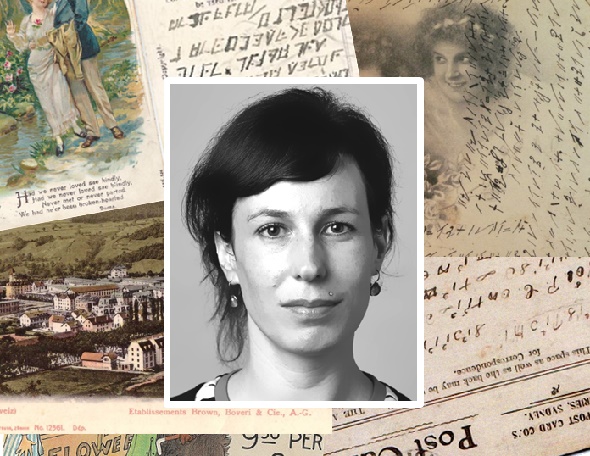Olivia von Westernhagen, who works as a journalist for the German computer magazine c’t, has provided me an article she wrote, which is based on material she found on my blog. It’s a great read, but it’s available in German only.
If you happen to read the German computer magazine c’t (I know that many do, as the c’t is very popular in the German-speaking region of Europe), you might have heard of Olivia von Westernhagen. Olivia is a member of the c’t editorial staff. Before working as a full-time journalist, she graduated in computer science and worked in the IT industry, specializing in IT security.

During her editorial traineeship at the c’t, Olivia wrote an article, which was never published. This article is about encrypted postcards. The material Olivia used stems from my blog and an interview I gave her. Olivia has given me permission to publish this article as a guest contribution on my blog. To my regret, it is only available in German. Here it is, have fun reading!
Amörle im Notenland – die verschlüsselten Postkarten des Josef Fröwis
Um 1900 turtelten Paare gern diskret per Postkarte: Geheimschriften machten es möglich. Ein österreichischer Musiker verschlüsselte Nachrichten an seine Verlobte so gekonnt, dass sie über 100 Jahre ungelesen blieben. Heute sind sie unterhaltsames Zeugnis einer Liebesgeschichte mit Höhen und Tiefen.
Alois Mayer, Postbote im Bezirk Bregenz in Österreich, studiert kopfschüttelnd die Korrespondenzkarte in seinen Händen. Auf ihrer Rückseite steht lediglich die Anschrift der Empfängerin: Fräulein Theresia Metzler. Die Vorderseite hingegen ist übersäht mit Noten, Violin- und Bassschlüsseln, die sich zu mehrfarbigen geometrischen Mustern aneinanderreihen. Sie tanzen vor den Augen des Postboten, der blinzelnd nach lesbarem Text sucht. Nach einer Weile zuckt er resigniert mit den Schultern, wirft die Karte in den Metzlerschen Briefschlitz und geht seiner Wege.
Auf der anderen Seite der Haustür wartet Theresia mit heißen Wangen auf Nachricht von ihrem Verlobten. Wie schon so oft in den vergangenen Monaten greift sie hastig nach dem bunt bemalten Papier und geht schnellen Schrittes auf ihr Zimmer. „Warum schreibt der Josef unserer Resi nie was G’scheites?“, brummt Vater Metzler seiner Frau zu. Die lächelt nur, denkt an ihre eigene Verlobungszeit, an die Ungeduld junger Verliebter – und an die kleinen Geheimnisse, die die Wartezeit überbrücken halfen.
Unterhosen für Vater Metzler
Auch die Nachkommen des verliebten Postkartenschreibers Josef Fröwis rätselten mehr als 100 Jahre lang über die Bedeutung der insgesamt 44 Nachrichten an Theresia Metzler. In der Annahme, der begeisterte Organist habe seine Kompositionen zu Papier gebracht, gaben sie einen Teil der Korrespondenz an einen Musikwissenschaftler weiter. Für diesen ergaben die Noten Sinn – wenn auch anders als gedacht: Er ersetzte jedes der Symbole durch einen Buchstaben und knackte auf diese Weise Fröwis‘ Geheimcode.
Das Bregenzerwald Archiv in Egg, das die Karten als Leihgabe erhielt, übernahm 2016 die akribische Entschlüsselung sämtlicher Nachrichten, die Fröwis seiner Verlobten zwischen 1898 und 1900 schickte. Sie erzählen von großen Gefühlen, aber auch von ganz banalen Alltagsdingen. „ICH MUSS DEM VATER UNTERHOSEN MITNEHMEN UND DAS HALSTUCH; WENN DIE MUTTER ZU HAUSE IST SO GEHE ICH! KOMME HEUTE BIS ½ 8 UHR.“, schreibt Josef aus Reuthe in die Nachbargemeinde Bizau. Da die Post damals bis zu dreimal täglich ausgefahren wurde, konnte er sicher sein, dass seine Verlobte rechtzeitig Bescheid wusste.
Dank geringer Portokosten im Vergleich zum Brief kam Postkarten damals die Bedeutung zu, die Instant Messaging heute hat. Emoji inklusive: Reisende verschickten statt umständlicher Landschaftsbeschreibungen Motivkarten, und Liebende griffen auf Blumenmotive und vorgedruckte Gedichte zurück. Ihre Kreativität investierten sie in Verschlüsselungstechniken, um intime Nachrichten auch ohne Briefumschlag vor neugierigen Postboten wie Alois Mayer zu verbergen.
Maria und ihr Herzensaugust
Die Chiffren mussten ausreichend sicher sein, ohne dass der Verfasser Gefahr lief, seine Angebetete durch stundenlange Entschlüsselungsprozeduren zu vergraulen. Zahlreiche Postkarten, die Klaus Schmeh, Experte für historische Verschlüsselungstechniken, in seinem Blog veröffentlicht hat, dokumentieren diese Gratwanderung: Triviale Buchstabenersetzungen herrschen vor, während Techniken wie Morsecode oder komplexe Zahlenverschlüsselungen die Ausnahme bilden.



Kommentare (8)